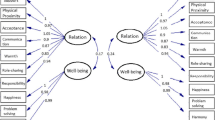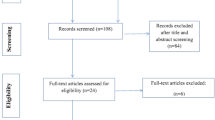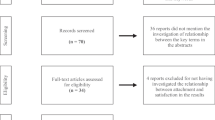Abstract
Marital quality in connection to its demographical and psychological correlates has been studied extensively in the West. In India also, it has been given considerable attention, but adequate exploration of relevant psychological variables is still wanting. The present study was conceptualized in this context to explore differences in the Personality factors, Attachment styles and Coping strategies in couples with good and poor marital quality. Data were collected from 90 couples for initial screening. Finally 20 couples with good marital quality and 20 couples with poor marital quality were selected based on scores of Marital Quality Scale. The tools used for screening were Marital Quality Scale and General Health Questionnaire-28. Other tools consisted of Neo Five Factor Inventory, Attachment style Questionnaire, and Coping Check list. Analysis revealed that the husbands with poor marital quality had higher neuroticism, less extraversion, less secure attachment style, less problem focused coping and acceptance, and greater denial than those with good marital quality. Wives with poor marital quality differed significantly from the wives with good marital quality in terms of less religious coping, acceptance and social support. The findings of the study may be utilized for advising maritally distressed couples by enhancing their coping resources and utilizing attachment potentials for furtherance of quality of married life.
Similar content being viewed by others

References
Acitelli, L. K., & Antonucci, T. C. (1994). Gender differences in the link between marital support and satisfaction in the older couples. Journal of Personality and Social Psychology, 76, 688–698.
Ahuja, A., García, O., Rossier, J., & García, L. F. (2005). Comparison of the NEO-FFI, the NEO-FFI-R and an alternative short version of the NEO-PI-R (NEO-60) in Swiss and Spanish samples. Personality and Individual Differences, 38, 591–604.
Aldwin, C. M., Sutton, K., & Lachman, M. (1996). The development of coping resources in adulthood. Journal of Personality, 64, 91–113.
Allendorf, K. (2009). The quality of family relationships. Women’s agency and maternal and child health in india, (Dissertation), University of Wisconsin-Madison, Madison.
Allendorf, K., & Ghimire, D. J. (2013). Determinants of marital quality in an arranged marriage society. Social Science Research, 42, 59–70.
Allgood, S. M., Crane, D. R., & Agee, L. (1997). Social support: distinguishing clinical and volunteer couples. The American Journal of Family Therapy, 25, 111–119.
Altman, I., & Taylor, D. A. (1973). The development of interpersonal relationships. Social Psychological Quarterly, 43, 59–72.
Amato, P. R., & Preveti, D. (2003). People’s reasons for divorcing gender social class the life course and adjustment. Journal of Family, 24, 602–615.
Banerjee, S. G. (1984). The Hindu law of marriage and Stridhana (4th ed.). Delhi: Mittal Publication.
Banse, R. (2004). Adult attachment and marital satisfaction: evidence for dyadic configuration effects. Journal of Social and Personal Relation, 21(2), 273–282.
Barelds, D. P. H., & Dijkstra, P. (2007). Lovers at first sight or friends first? Ties between partner personality trait similarity, love and relationship quality. Journal of Social and Personal Relationships, 24(4), 479–496.
Barelds, D. P. H., & Dijkstra, P. (2011). Positive illusions about a partner’s personality and relationship quality. Journal of Research in Personality, 45, 37–43.
Bartholomew, K., & Horowitz, L. M. (1991). Attachment style among adults. A test of a four category model. Journal of Personality and Social Psychology, 61, 226–244.
Basu, S., & Dasgupta, S. K. (1996). Adapted Bengali version of General Health Questionnaire-28. Calcutta. Dept. of Applied Psychology. University of Calcutta.
Batool, S. S., & Khalid, R. (2012). Emotional intelligence: a predictor of marital quality in Pakistani couples. Pakistan Journal of Psychological Research, 27(1), 65–88.
Ben-Ari, A., & Lave, Y. (2005). Dyadic characteristics of individual attributes: attachment, neuroticism, and their relation to marital quality and closeness. American Journal of Orthopsychiatry, 75(4), 621–631.
Bodenmann, G., Pihet, S., & Kayser, K. (2006). The relationship between dyadic coping and marital quality: a 2-year longitudinal study. Journal of Family Psychology, 20, 485–493.
Bradbury, T. N., Fincham, F. D., & Beach, S. R. H. (2000). Research on the nature and determinants of marital satisfaction: a decade in review. Journal of Marriage and the Family, 62, 964–980.
Brimhall, A., Wampler, K., & Klmball, T. (2008). Learning from the past, altering the future: a tentative theory of the effect of past relationships on couples who remarry. Family Process 47, no. 3. http://www.highbeam.com/doc/1P3-1562196131.html.
Bulanda, J. R., & Brown, S. L. (2007). Race-ethnic differences in marital quality and divorce. Social Science Research, 36, 945–967.
Buunk, B. P., & Mutsaers, W. (1999). Equity perceptions and marital satisfaction in former and current marriage: a study among the remarried. Journal of Social and Personal Relationships, 16(1), 123–132.
Byrne, D. (1971). The attraction paradigm. NY: Academic.
Cherlin, A. J., & Furstenberg, F. F. (1994). Stepfamilies in the United States: A reconsideration. In J. Black & J. Hagen (Eds.), Annual review of sociology (pp. 359–381). Palo Alto: Annual Reviews.
Claxton, A., O’Rourke, N., Smith, J. Z., & DeLongis, A. (2012). Personality traits and marital satisfaction within enduring relationships: an intra-couple discrepancy approach. Journal of Social and Personal Relationships, 29, 375–396.
Collins, N. L. (1996). Working models of attachment. Implication for explanation, emotion and behaviour. Journal of Personality and Social Psychology, 71, 810–832.
Dasgupta, S. K., & Basu, S. (1997). Adapted Bengali version of general health questionnaire-28. Calcutta: Dept. of Applied Psychology.
Dasgupta, S., & Basu, J. (2001). Effects of gender role identity of couples and earning status of the wife on marital quality. Social Science International, 17, 16–30.
Dasgupta, S., & Basu, J. (2011). Marital quality and gender role stereotype. Psychological Studies, 56(4), 360–367.
Dasgupta, S., Basu, J., & Chaudhuri, A. (2004). Impact of gender, earning status of the wife, and gender role attitude on marital quality as perceived by the spouse. Journal of the Indian Academy of Applied Psychology, 30, 131–143.
Dhar, S., & Basu, S. (2009). Identity consistency and its relationship with attachment stles and quality of marital life. Journal of Psychometry, 23, 26–34.
Dijkstra, P., & Barelds, D. P. H. (2008). Do people know what they want: a similar or a complimentary partner? Evolutionary Psychology, 6, 595–602.
Eastwick, P. W., & Finkel, E. J. (2008). Sex differences in mate preferences revisited: do people know what they initially desire in a romantic partner? Journal of Personality and Social Psychology, 94, 245–264.
Gallo, L. G., & Smith, T. W. (2001). Attachment style in marriage: adjustment and responses to interaction. Journal of Social and Personal Relationships, 18, 263–289.
Ganth, B., Thiyagarajan, S., & Nigesh. (2013). Role of infertility, emotional intelligence and resilience on marital satisfaction among Indian couples. International Journal of Applied Psychology, 3, 31–37.
Goel, S., Narang, D. K., & Koradia, K. (2013). Marital adjustment and mental health among bank employees and doctors during middle age (40–55 years) in Delhi. International Journal of Scientific and Research Publications, 3 (1). Downloaded from http://www.ijsrp.org/research-paper-1301/ijsrp-p1326.pdf on 1.06.2013
Goldberg, D. P., & Hiller, V. F. (1979). A scaled version of general health questionnaire. Psychological Medicine, 9, 139–45.
Goldberg, P., & Williams, P. (1988). A user’s guide to the general health questionnaire. Windsor: NFER-NELSON.
Hazan, C., & Shaver, P. (1989). Romantic love conceptualized as an attachment process. Journal of Personality and Social Psychology, 52, 511–524.
Isaac, R., & Shah, A. (2004). Sex roles and marital adjustment in Indian couples. International Journal of Social Psychiatry, 50, 129.
Johnson, N., Backlund, E., Sorlie, P., & Loveless, C. (2000). Marital status and mortality: the national longitudinal mortality study. Annals of Epidemiology, 2000(10), 224–238.
Karney, B. R., & Bradbury, T. N. (1995). The longitudinal course of marital quality and stability: a review of theory, method and research. Psychological Bulletin, 118, 3–34.
Kearns, J. N., & Leonard, K. E. (2004). Social networks, structural interdependence, and marital quality over the transition to marriage: a prospective analysis. Journal of Family Psychology, 18(2), 383–395.
Kelly, E. L., & Conley, J. J. (1987). Personality and compatibility: a prospective analysis of marital stability and marital satisfaction. Journal of Personality and Social Psychology, 52, 27–40.
Khan, F., & Aftab, S. (2013). Marital satisfaction and perceived social support as vulnerability factors to depression. American International Journal of Social Science, 2(5), 99–107.
Kirkpatrick, L. A., & Davis, K. E. (1994). Attachment style, gender and relationship stability: a longitudinal analysis. Journal of Personality and Social Psychology, 66, 502–512.
Kurdek, L. A. (1993). Predicting marital dissolution: a 5-year prospective longitudinal study of newlywed couples. Journal of Personality and Social Psychology, 64, 221–242.
Kurdek, L. A. (2005). Gender and marital satisfaction early in marriage: a growth curve approach. Journal of Marriage and Family, 67, 68–84.
Lodhi, P. H., Deo, S., & Belhekar, V. M. (2002). The five-factor model of personality in Indian context: measurement and correlates. In R. R. McCrae & J. Allik (Eds.), The five-factor model of personality across cultures (pp. 227–248). N.Y.: Kluwer Academic Publisher.
McAllister, F. (1995). Marital breakdown and the health of the nation (2nd ed.). London: One Plus One.
McCrae, R. R., Costa, P. T., & Martin, T. A. (2005). The NEO-PI-3: a more readable revised NEO personality inventory. Journal of Personality Assessment, 84(3), 261–270.
McCrae, R. R., Martin, T. A., Hrebícková, M., Urbánek, T., Boomsma, D. I., Willemsen, G., & Costa, P. T. (2008). Personality trait similarity between spouses in four cultures. Journal of Personality, 76, 1137–1164.
Miller, B. C. (1976). A multivariate developmental model of marital satisfaction. Journal of Marriage & Family, 38, 643–657.
Mohan, V., & Singh, S. (1985). Eysenck’s personality dimension as related to marital adjustment. Indian Journal of Community Guidance Service, 2(1), 25–33.
Nambi, S. (2005). Marriage, mental health and the Indian legislation presidential address. Indian Journal of Psychiatry, 2005(47), 3–14.
O’Brien, T. B., DeLOngis, A., Pomaki, G., Puterman, E., & Zwicker, A. (2009). Couples coping with stress: the role of empathic responding. European Psychologist, 14, 18–28.
Pargament, K. I., Tarakeshwar, N., Ellison, C. G., & Wulff, K. M. (2001). Religious coping among the religious: the relationships between religious coping and well-being in a national sample of Presbyterian clergy, elders, and members. Journal for the Scientific Study of Religion, 40, 497.
Pasch, L. A., & Bradbury, T. N. (1998). Social support, conflict and the development of marital dysfunction. Journal of Counseling and Clinical Psychology, 66(2), 219–230.
Phelps, S. B., & Jarvis, P. A. (1994). Coping in adolescence: empirical evidence for a theoretically based approach to assessing coping. Journal of Youth and Adolescence, 23, 359–371.
Rammstedt, B., & Schupp, J. (2008). Only the congruent survive-personality similarities in couples. Personality and Individual Differences, 45, 533–535.
Rao, K., Subbakrishna, D. K., & Prabhu, G. G. (1989). Development of coping check list—a preliminary report. Indian Journal of Psychiatry, 31(2), 128–133.
Ravi Kumar, B. P., Dudala, S. R., & Rao, A. R. (2013). Kuppuswamy’s socio-economic status scale—a revision of economic parameter for 2012. International Journal of Research & Development of Health, 1(1), 2–4.
Rogers, S. J., & Amato, P. R. (2000). Have changes in gender relations affected marital quality? Social Forces, 79, 731–753.
Ross, C. E., Mirowsky, J., & Goldsteen, K. (1990). The impact of the family on health: the decade in review. Journal of Marriage and the Family, 52, 1059–1078.
Shah, A. (1995). Clinical validity of marital quality scale. NIMHANS Journal, 3, 23–33.
Simpson, J. A. (1990). Influence of attachment styles on romantic relationships. Journal of Personality and Social Psychology, 59, 971–980.
Singh, R., Thind, S. K., & Jaswal, S. (2006). Assessment of marital adjustment among couples with respect to women’s education level and employment status. Anthropologist, 8(4), 259–266.
Spanier, G., & Lewis, R. (1980). Marital quality: a review of the seventies. Journal of Marriage and the Family, 42, 96–110.
Spotts, E. L., Neiderhiser, J. M., Ganiban, J., Reiss, D., Lichtenstein, P., Hansson, K., Cederblad, M., & Pedersen, N. L. (2004). Accounting for depressive symptoms in women: a twin study of associations with interpersonal relationships. Journal of Affective Disorders, 82, 101–111.
Spotts, E. L., Lichtenstein, P., Pedersen, N., Neiderhiser, J. M., Hansson, K., Cederblad, M., & Reiss, D. (2005). Personality and marital satisfaction: a behavioural genetic analysis. European Journal of Personality, 19, 205–227. doi:10.1002/per.545.
Srivastava, A. (2013). Marriage as a perceived panacea to mental illness in India: reality check. Indian Journal of Psychiatry, 55, 239–242.
Taylor, S. E., & Aspinwall, L. G. (1996). Mediating and moderating processes in psychosocial stress: Appraisal, coping, resistance and vulnerability. In H. B. Kaplan (Ed.), Psychological stress: Perspectives on structure, theory, life-course and methods (pp. 71–110). San Diego: Academic.
Umberson, D., Williams, K., Powers, D. A., Liu, H., & Needham, B. (2006). You make me sick: marital quality and health over the life course. Journal of Health and Social Behavior, 47, 1–16.
Van Oudenhoven, J. P. L. M., Hofstra, J., & Bakker, W. (2003). Outwikkeling en evaluatie van de hechtinsstij luragenlijst (HSL). [Development and evaluation of the attachment style questionnaire]. Nederlands Tijdschrift voor de Psychologic, 58, 95–102.
Wickrama, K. A. S., Lorenz, F. O., Conger, R. D., & Elder, G. H. (1997). Marital quality and physical illness: a latent growth curve analysis. Journal of Marriage and Family, 59, 143–155.
Williams, K. (2003). Has the future of marriage arrived? A contemporary examination of gender, marriage, and psychological well-being. Journal of Health and Social Behavior, 44, 470–487.
Wilson, C. M., & Oswald, A. J. (2005). How does marriage affect physical and psychological health? A survey of the longitudinal evidence. Bonn, Germany, Institute for the Study of Labor, Disc. Paper #1619 http://www.iza.org/en/webcontent/publications/papers?dp_id=1619.
Author information
Authors and Affiliations
Corresponding author
Rights and permissions
About this article
Cite this article
Banerjee, S., Basu, J. Personality Factors, Attachment Styles and Coping Strategies in Couples with Good and Poor Marital Quality. Psychol Stud 59, 59–67 (2014). https://doi.org/10.1007/s12646-013-0233-7
Received:
Accepted:
Published:
Issue Date:
DOI: https://doi.org/10.1007/s12646-013-0233-7



